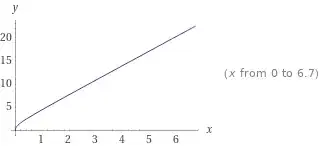The Closed Form:
I have derived a closed form, using Mathematica functions, for the inverse of the function, based on this series definition. First, let’s find the closed form for:
$$\tan(x)=x\iff \frac{\sin(x)}x=\cos(x)\iff\sqrt\frac{2}{\pi x}\left(\frac{\sin(x)}x-\cos(x)\right)=\text J_\frac32(x)=0$$
where appears the Bessel J function mentioned in OEIS A$115365$. Now use the Bessel J zero function $\text j_{n,x}$:
$$\text J_\frac32(x)=0 \implies x=\text j_{\frac32,n\in\Bbb N}\implies \tan(\text j_{\frac32,n} )= \text j_{\frac32,n }$$
Test the formula here with the $n$th real zero. See here for a sum of Bessel J zeros
Therefore:
$$\boxed{\tan(x)=x\implies x=\text j_{\frac32, n\in\Bbb N}\sim\pi n}:$$

The “closed form” of the inverse of $\tan(x)-x$:
Our goal is to use The series definition of Inverse Beta Regularized $\text I^{-1}_z(a,b)$ about $z=0$ to extend it’s domain and technically get a closed form. Here are some definitions including the Regularized Beta function $\text I_z(a,b)$ where it’s inverse calculates the quantile:
$$\text I_z(a,b)=\frac{\int_0^z t^{a-1} (1-t)^{b-1}dt}{\int_0^1 t^{a-1} (1-t)^{b-1}dt }=x \mathop\implies^{0\le x\le 1}_{a,b>0}z=\text I^{-1}_x(a,b)$$
The restrictions on $z$ make there be an inverse. Now observe that:
$$-\frac\pi2 \text I_{\sin^2(z)}\left(\frac32,-\frac12\right)=-\frac\pi2\int_0^{\sin^2(z)} \frac {\sqrt z}{2(1-z)^\frac32}dz=\tan(z)-z=x\implies z\mathop=^{0\le z\le \frac\pi2}\sin^{-1}\sqrt{\text I^{-1}_{-\frac{2x}\pi}\left(\frac32,-\frac12\right)}$$
but $b<0$, so Wolfram Alpha will not evaluate the function. However, there is a series expansion:
$$\text I^{-1}_z(a,b)\mathop=^{a>0}(az\text B(a,b))^\frac1a+\frac{b-1}{a+1} (az\text B(a,b))^\frac 2a+ \frac{(b-1)(a^2+3ab-a+5b-4)}{2(a+1)^2(a+2)}(az\text B(a,b))^\frac 3a +…$$
Here is a plot of the expansion up to $4$ terms with the principal root. The inverse is accurate enough for $|z|<\frac12$. Using the link’s further terms is hard in Wolfram Alpha since the coefficients are too long to type out:
$$\boxed{z=\tan(y)-y\implies y\mathop=^\text{series}_\text{extension}\sin^{-1}\sqrt{\text I^{-1}_{-\frac{2z}\pi}\left(\frac32,-\frac12\right)} = \sin^{-1}\sqrt{3^\frac23x^\frac23-\frac95\sqrt[3]3x^\frac43+\frac{432}{175}x^2-\frac{821}{875}3^\frac23 x^\frac83+…}}$$

Test the series here. Evaluation of more series terms are needed.
Actual Closed forms for the inverse:
See here for a 2 closed form answers to the inverse function of $x-\tan(x)$ where one is with a limit.
Please correct me and give me feedback!

